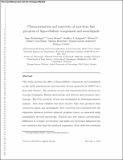| dc.contributor.author | Trubetskaya, Anna | |
| dc.contributor.author | Brown, Avery | |
| dc.contributor.author | Tompsett, Geoffrey A. | |
| dc.contributor.author | Timko, Michael T. | |
| dc.contributor.author | Kling, Jens | |
| dc.contributor.author | Broström, Markus | |
| dc.contributor.author | Andersen, Mogens Larsen | |
| dc.contributor.author | Umeki, Kentaro | |
| dc.date.accessioned | 2018-05-16T10:35:31Z | |
| dc.date.issued | 2018-02-06 | |
| dc.identifier.citation | Trubetskaya, A., Brown, A., Tompsett, G. A., Timko, M. T., Kling, J., Broström, M., Andersen, M. L., Umeki, K. (2018). Characterization and reactivity of soot from fast pyrolysis of lignocellulosic compounds and monolignols. Applied Energy, 212, 1489-1500. doi: https://doi.org/10.1016/j.apenergy.2017.12.068 | en_IE |
| dc.identifier.issn | 0306-2619 | |
| dc.identifier.uri | http://hdl.handle.net/10379/7362 | |
| dc.description.abstract | This study presents the effect of lignocellulosic compounds and monolignols on the yield, nanostructure and reactivity of soot generated at 1250 C in a drop tube furnace. The structure of soot was characterized by electron microscopy techniques, Raman spectroscopy and electron spin resonance spectroscopy. The CO2 reactivity of soot was investigated by thermogravimetric analysis. Soot from cellulose was more reactive than soot produced from extractives, lignin and monolignols. Soot reactivity was correlated with the separation distances between adjacent graphene layers, as measured using transmission electron microscopy. Particle size, free radical concentration, differences in a degree of curvature and multi-core structures influenced the soot reactivity less than the interlayer separation distances. Soot yield was correlated with the lignin content of the feedstock. The selection of the extraction solvent had a strong influence on the soot reactivity. The Soxhlet extraction of softwood and wheat straw lignin soot using methanol decreased the soot reactivity, whereas acetone extraction had only a modest effect. | en_IE |
| dc.description.sponsorship | The authors gratefully acknowledge financial support from the National Science Foundation (Grant EEC-1605916), Kempe Foundation, the Swedish Energy Agency, the Swedish strategic research program Bio4Energy, Carl-Fredrik von Horns, Björn Wahlströms, and Jernkontoret Stiftelsen. The A.P. Møller and Chastine Mc-Kinney Møller Foundation is acknowledged for their contribution toward the establishment of the Center for Electron Nanoscopy in the Technical University of Denmark. Gerrit Surup from University of Agder is acknowledged for assisting with the ultimate and proximate analysis. | en_IE |
| dc.format | application/pdf | en_IE |
| dc.language.iso | en | en_IE |
| dc.publisher | Elsevier | en_IE |
| dc.relation.ispartof | Applied Energy | en |
| dc.rights | Attribution-NonCommercial-NoDerivs 3.0 Ireland | |
| dc.rights.uri | https://creativecommons.org/licenses/by-nc-nd/3.0/ie/ | |
| dc.subject | Fast pyrolysis | en_IE |
| dc.subject | Lignocellulosic compounds and monolignols | en_IE |
| dc.subject | Soot | en_IE |
| dc.subject | Reactivity | en_IE |
| dc.subject | Nanostructure | en_IE |
| dc.title | Characterization and reactivity of soot from fast pyrolysis of lignocellulosic compounds and monolignols | en_IE |
| dc.type | Article | en_IE |
| dc.date.updated | 2018-05-08T17:47:28Z | |
| dc.identifier.doi | 10.1016/j.apenergy.2017.12.068 | |
| dc.local.publishedsource | https://doi.org/10.1016/j.apenergy.2017.12.068 | en_IE |
| dc.description.peer-reviewed | peer-reviewed | |
| dc.contributor.funder | National Science Foundation | en_IE |
| dc.contributor.funder | Kempe Foundation | en_IE |
| dc.contributor.funder | Swedish Energy Agency | en_IE |
| dc.description.embargo | 2020-02-06 | |
| dc.internal.rssid | 14302867 | |
| dc.local.contact | Anna Trubetskaya, Mechanical Engineering, College Of Engineering And Informatics, Nui Galway. - Email: anna.trubetskaya@nuigalway.ie | |
| dc.local.copyrightchecked | No | |
| dc.local.version | PUBLISHED | |
| nui.item.downloads | 234 | |


